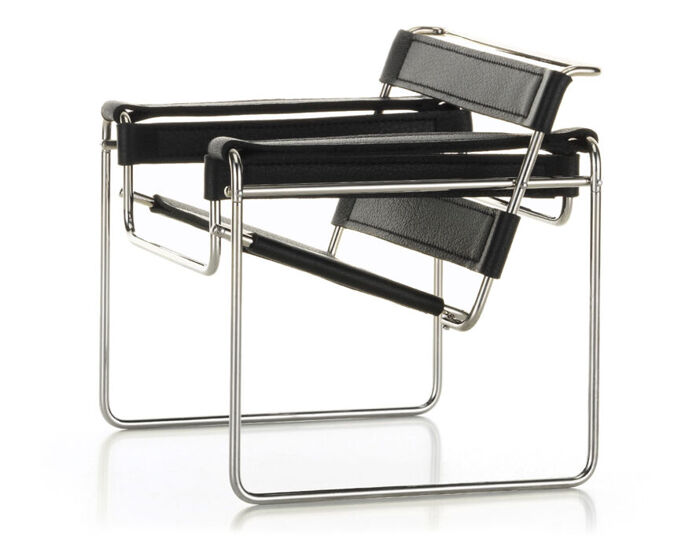Miniature B3 Wassily Chair
by Marcel Breuer from Vitra.
miniature b3 wassily chair
Design Marcel Breuer, 1925
1/6 miniature scale model
Made in Poland by Vitra
For over two decades, the Vitra Design Museum has been making miniature replicas of milestones in furniture design. The Miniatures Collection encapsulates the entire history of industrial furniture design - moving from Historicism and Art Nouveau to the New Objectivity of Bauhaus and Radical Design, and from Postmodernism all the way up to the present day. Exactly one sixth of the size of the historical originals, the chairs are all true to scale and precisely recreate the smallest details of construction, material and color. The high standard of authenticity even extends to the natural grain of the wood, the reproduction of screws and the elaborate handicraft techniques involved. This has made the miniatures into popular collector's items as well as ideal illustrative material for universities, design schools and architects.
Marcel Breuer was one of the most important designers of the early modern age. His biography is closely linked to the history of the Bauhaus, founded by Walter Gropius in 1919. The club chair B3, known today as "Wassily" was also created in connection with this renowned institution. It is the first piece of seating furniture in the history of design to be made from seamless, precision-drawn tubular steel. Its transparency and visible structure are expressions of the stringent aesthetic approach that prevailed in architecture and design following World War I.
Marcel Breuer replaced the massive upholstered corpus of the traditional club chair with a skeleton-like construction made out of bent steel tubing, thereby overcoming the physical weightiness of conventional seating. He exploited the elasticity of the material, complementing it with tautly stretched fabric strips of reinforced canvas for the seat and back. The B3 did not acquire the name "Wassily" until the beginning of the sixties, when the Italian furniture producer Dino Gavina purchased the manufacturing rights: Marcel Breuer had designed the armchair for the house of the painter Wassily Kandinsky, who taught at the Bauhaus from 1922 until 1933.
Each Vitra miniature is true to the original in construction and materials, and reduced in size on a scale of 1:6. Each miniature is packaged in a wooden box, accompanied by an informational booklet. Production notes: Each of the delicate objects are made by hand; on average, each miniature requires five hours of careful manual work. Ongoing quality control ensures that every miniature corresponds to its larger original in terms of finishing, details and materials.
4.9" h | 4.9" w | 4.5" d
1/6 miniature scale model
Made in Poland by Vitra
For over two decades, the Vitra Design Museum has been making miniature replicas of milestones in furniture design. The Miniatures Collection encapsulates the entire history of industrial furniture design - moving from Historicism and Art Nouveau to the New Objectivity of Bauhaus and Radical Design, and from Postmodernism all the way up to the present day. Exactly one sixth of the size of the historical originals, the chairs are all true to scale and precisely recreate the smallest details of construction, material and color. The high standard of authenticity even extends to the natural grain of the wood, the reproduction of screws and the elaborate handicraft techniques involved. This has made the miniatures into popular collector's items as well as ideal illustrative material for universities, design schools and architects.
Marcel Breuer was one of the most important designers of the early modern age. His biography is closely linked to the history of the Bauhaus, founded by Walter Gropius in 1919. The club chair B3, known today as "Wassily" was also created in connection with this renowned institution. It is the first piece of seating furniture in the history of design to be made from seamless, precision-drawn tubular steel. Its transparency and visible structure are expressions of the stringent aesthetic approach that prevailed in architecture and design following World War I.
Marcel Breuer replaced the massive upholstered corpus of the traditional club chair with a skeleton-like construction made out of bent steel tubing, thereby overcoming the physical weightiness of conventional seating. He exploited the elasticity of the material, complementing it with tautly stretched fabric strips of reinforced canvas for the seat and back. The B3 did not acquire the name "Wassily" until the beginning of the sixties, when the Italian furniture producer Dino Gavina purchased the manufacturing rights: Marcel Breuer had designed the armchair for the house of the painter Wassily Kandinsky, who taught at the Bauhaus from 1922 until 1933.
Each Vitra miniature is true to the original in construction and materials, and reduced in size on a scale of 1:6. Each miniature is packaged in a wooden box, accompanied by an informational booklet. Production notes: Each of the delicate objects are made by hand; on average, each miniature requires five hours of careful manual work. Ongoing quality control ensures that every miniature corresponds to its larger original in terms of finishing, details and materials.
4.9" h | 4.9" w | 4.5" d
Marcel Breuer
Breuer was a student and teacher at Bauhaus. His most famous design was the Wassily chair, inspired by bicycle handlebars.
In London Breuer was employed by the Isokon company, a pioneer of modern design in the UK. Breuer taught at Harvard with pupils such as Philip Johnson and I.M. Pei. He designed many houses in the Boston area alongside former Bauhaus colleague Walter Gropius.
Vitra is a Swiss company dedicated to improving the quality of life through the power of design. A central goal of Vitra is sustainable development. Trendy styling is avoided in favor of classic pieces that can be used for decades.












 write a review now
write a review now
